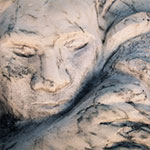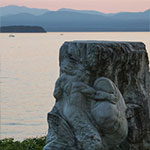Focal Places in Burlington
The Waterfront: Mysteries of the Waterfront
A House with a Unique History
This house at 22-24 Blodgett St once occupied a very different address. Click on this illustrated map below to see where it was originally located.
Local lore tells that this prefabricated house arrived in Burlington by accident in 1874; it was intended for Buffalo, NY. Rather than send it on or back to its source, local bureaucrats consulted with War Department engineers and decided to install the house on the Burlington Breakwater, for occupancy by the lightkeepers of Burlington Harbor. For reasons unknown but perhaps imaginable, the house was never occupied. It was sold at auction in 1884 and moved to its present location in Burlington's Old North End.
Marble Art
Walk south from Perkins Pier on the Burlington bike path and just past the water treatment plant you will come across some pieces of artwork. The large marble sculptures look as though they have been washed ashore from a shipwreck, but they are in fact the conception of Justin Rose, a local stone carver. The sculptures were created on site from pieces of marble found at the water’s edge.
These sculptures celebrate the geological “marble corridor” that runs along the western edge of Vermont and the marble that was used as fill for the Burlington waterfront (that’s why the large pieces could be found there). They are a stop on the Vermont Marble Trail.
Why does marble occur on the western edge of Vermont? Many millions of years ago, the land we now know as Vermont was covered by a warm, shallow sea called the Iapetus Ocean. This was a tropical sea full of coral reefs. The bodies of sea creatures layered up as sediment at the bottom of the ocean over time, eventually hardening into calcium-rich limestone. As the tectonic plates of the Earth’s crust moved 450 million years ago, pieces of land slowly collided in a period of mountain-building called the Taconic orogeny. The heat and pressure of this event, which folded the rocks that formed the base of the Green Mountains, also transformed the layers of limestone at the western edge of Vermont into marble.
Listen to Justin Rose speaking about the origins of marble
Listen to Justin Rose speaking about the process




